Analysis of Service Recovery and Customer Satisfaction at Starbucks
VerifiedAdded on 2020/04/07
|8
|1655
|569
Report
AI Summary
This report delves into the critical aspects of service recovery and customer satisfaction within the context of Starbucks. It begins by defining "moments of truth" and illustrating their significance in shaping customer perceptions. The report examines the key determinants of customer satisfaction and dissatisfaction, highlighting factors such as product quality, performance, and expectations. It then explores various tools and models for measuring service quality, including customer feedback mechanisms, complaint policies, and benchmarking against competitors. The SERVQUAL and SERVPERF models are discussed, emphasizing how these frameworks assess the gaps between customer expectations and perceptions of service delivery. The analysis underscores the importance of understanding and addressing customer needs to foster loyalty, encourage repeat business, and generate positive word-of-mouth marketing. Ultimately, the report emphasizes the critical role of service quality in driving overall business success, especially in service-oriented industries like Starbucks.
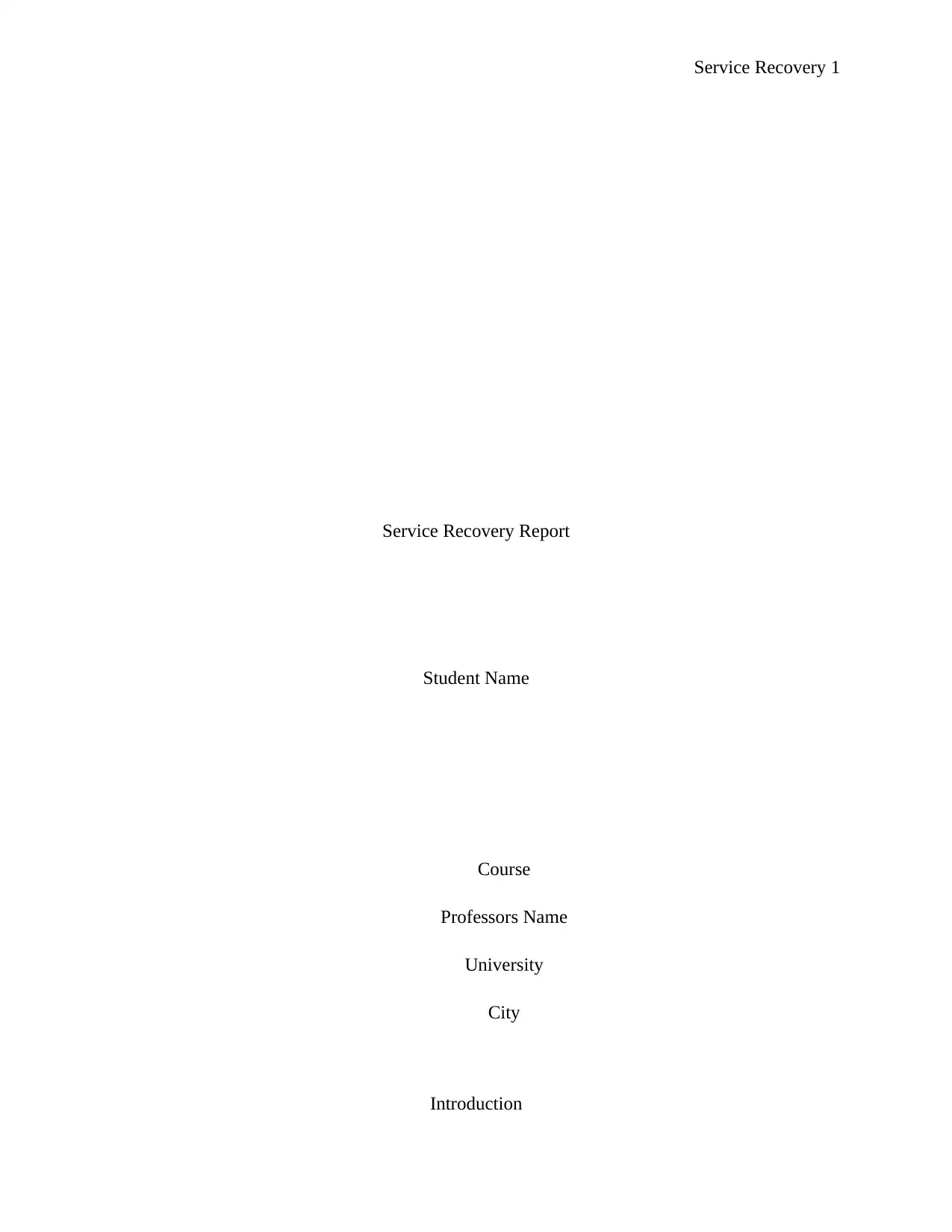
Service Recovery 1
Service Recovery Report
Student Name
Course
Professors Name
University
City
Introduction
Service Recovery Report
Student Name
Course
Professors Name
University
City
Introduction
Paraphrase This Document
Need a fresh take? Get an instant paraphrase of this document with our AI Paraphraser
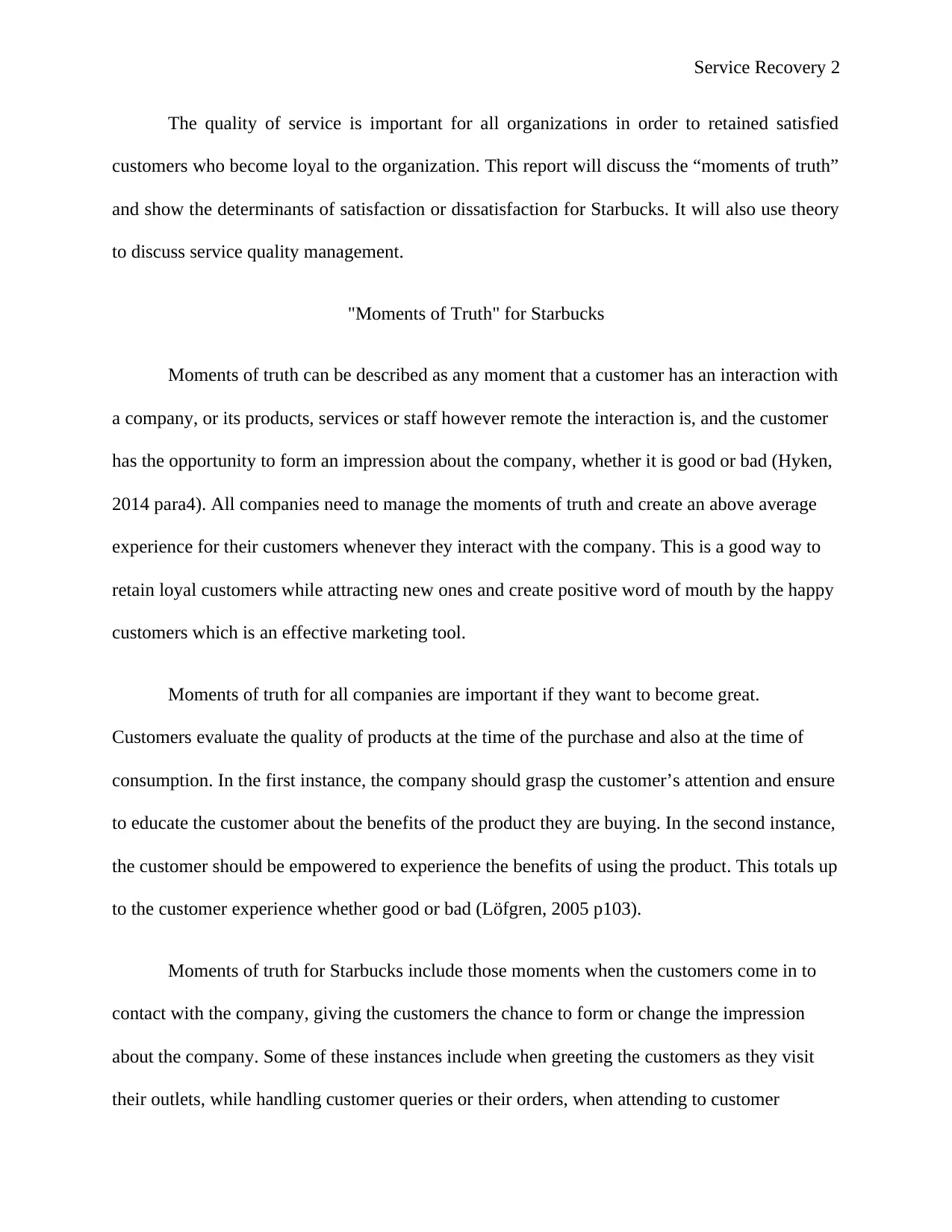
Service Recovery 2
The quality of service is important for all organizations in order to retained satisfied
customers who become loyal to the organization. This report will discuss the “moments of truth”
and show the determinants of satisfaction or dissatisfaction for Starbucks. It will also use theory
to discuss service quality management.
"Moments of Truth" for Starbucks
Moments of truth can be described as any moment that a customer has an interaction with
a company, or its products, services or staff however remote the interaction is, and the customer
has the opportunity to form an impression about the company, whether it is good or bad (Hyken,
2014 para4). All companies need to manage the moments of truth and create an above average
experience for their customers whenever they interact with the company. This is a good way to
retain loyal customers while attracting new ones and create positive word of mouth by the happy
customers which is an effective marketing tool.
Moments of truth for all companies are important if they want to become great.
Customers evaluate the quality of products at the time of the purchase and also at the time of
consumption. In the first instance, the company should grasp the customer’s attention and ensure
to educate the customer about the benefits of the product they are buying. In the second instance,
the customer should be empowered to experience the benefits of using the product. This totals up
to the customer experience whether good or bad (Löfgren, 2005 p103).
Moments of truth for Starbucks include those moments when the customers come in to
contact with the company, giving the customers the chance to form or change the impression
about the company. Some of these instances include when greeting the customers as they visit
their outlets, while handling customer queries or their orders, when attending to customer
The quality of service is important for all organizations in order to retained satisfied
customers who become loyal to the organization. This report will discuss the “moments of truth”
and show the determinants of satisfaction or dissatisfaction for Starbucks. It will also use theory
to discuss service quality management.
"Moments of Truth" for Starbucks
Moments of truth can be described as any moment that a customer has an interaction with
a company, or its products, services or staff however remote the interaction is, and the customer
has the opportunity to form an impression about the company, whether it is good or bad (Hyken,
2014 para4). All companies need to manage the moments of truth and create an above average
experience for their customers whenever they interact with the company. This is a good way to
retain loyal customers while attracting new ones and create positive word of mouth by the happy
customers which is an effective marketing tool.
Moments of truth for all companies are important if they want to become great.
Customers evaluate the quality of products at the time of the purchase and also at the time of
consumption. In the first instance, the company should grasp the customer’s attention and ensure
to educate the customer about the benefits of the product they are buying. In the second instance,
the customer should be empowered to experience the benefits of using the product. This totals up
to the customer experience whether good or bad (Löfgren, 2005 p103).
Moments of truth for Starbucks include those moments when the customers come in to
contact with the company, giving the customers the chance to form or change the impression
about the company. Some of these instances include when greeting the customers as they visit
their outlets, while handling customer queries or their orders, when attending to customer
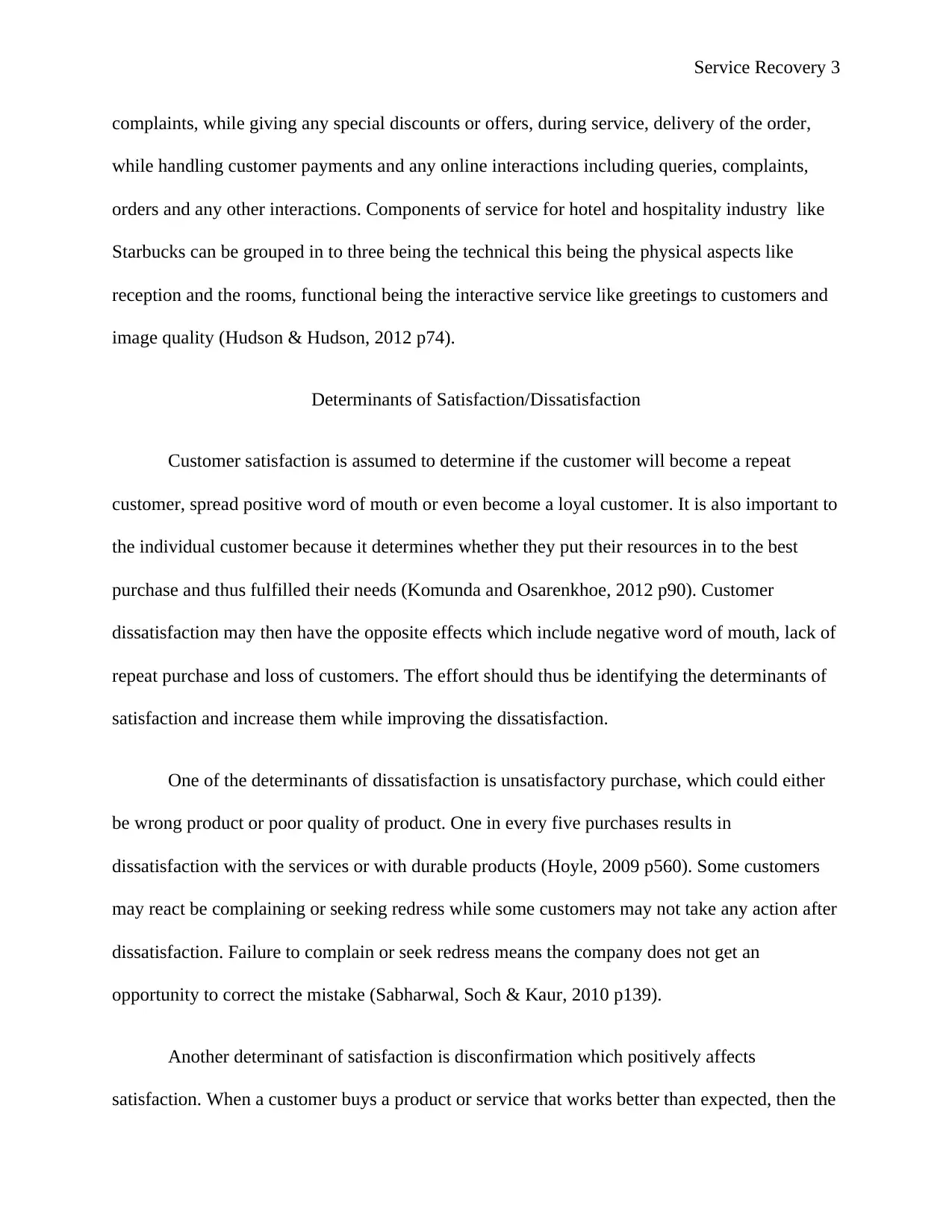
Service Recovery 3
complaints, while giving any special discounts or offers, during service, delivery of the order,
while handling customer payments and any online interactions including queries, complaints,
orders and any other interactions. Components of service for hotel and hospitality industry like
Starbucks can be grouped in to three being the technical this being the physical aspects like
reception and the rooms, functional being the interactive service like greetings to customers and
image quality (Hudson & Hudson, 2012 p74).
Determinants of Satisfaction/Dissatisfaction
Customer satisfaction is assumed to determine if the customer will become a repeat
customer, spread positive word of mouth or even become a loyal customer. It is also important to
the individual customer because it determines whether they put their resources in to the best
purchase and thus fulfilled their needs (Komunda and Osarenkhoe, 2012 p90). Customer
dissatisfaction may then have the opposite effects which include negative word of mouth, lack of
repeat purchase and loss of customers. The effort should thus be identifying the determinants of
satisfaction and increase them while improving the dissatisfaction.
One of the determinants of dissatisfaction is unsatisfactory purchase, which could either
be wrong product or poor quality of product. One in every five purchases results in
dissatisfaction with the services or with durable products (Hoyle, 2009 p560). Some customers
may react be complaining or seeking redress while some customers may not take any action after
dissatisfaction. Failure to complain or seek redress means the company does not get an
opportunity to correct the mistake (Sabharwal, Soch & Kaur, 2010 p139).
Another determinant of satisfaction is disconfirmation which positively affects
satisfaction. When a customer buys a product or service that works better than expected, then the
complaints, while giving any special discounts or offers, during service, delivery of the order,
while handling customer payments and any online interactions including queries, complaints,
orders and any other interactions. Components of service for hotel and hospitality industry like
Starbucks can be grouped in to three being the technical this being the physical aspects like
reception and the rooms, functional being the interactive service like greetings to customers and
image quality (Hudson & Hudson, 2012 p74).
Determinants of Satisfaction/Dissatisfaction
Customer satisfaction is assumed to determine if the customer will become a repeat
customer, spread positive word of mouth or even become a loyal customer. It is also important to
the individual customer because it determines whether they put their resources in to the best
purchase and thus fulfilled their needs (Komunda and Osarenkhoe, 2012 p90). Customer
dissatisfaction may then have the opposite effects which include negative word of mouth, lack of
repeat purchase and loss of customers. The effort should thus be identifying the determinants of
satisfaction and increase them while improving the dissatisfaction.
One of the determinants of dissatisfaction is unsatisfactory purchase, which could either
be wrong product or poor quality of product. One in every five purchases results in
dissatisfaction with the services or with durable products (Hoyle, 2009 p560). Some customers
may react be complaining or seeking redress while some customers may not take any action after
dissatisfaction. Failure to complain or seek redress means the company does not get an
opportunity to correct the mistake (Sabharwal, Soch & Kaur, 2010 p139).
Another determinant of satisfaction is disconfirmation which positively affects
satisfaction. When a customer buys a product or service that works better than expected, then the
⊘ This is a preview!⊘
Do you want full access?
Subscribe today to unlock all pages.

Trusted by 1+ million students worldwide
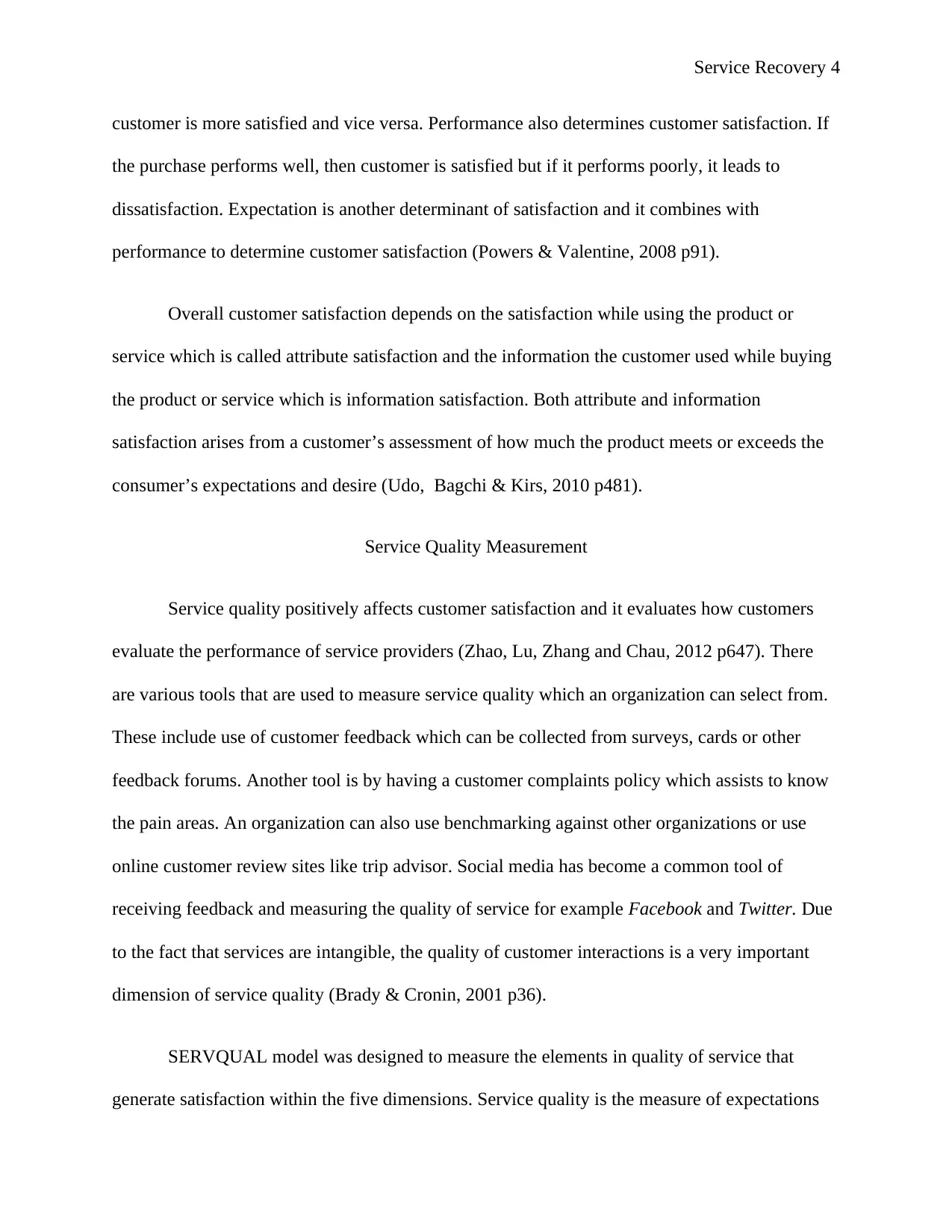
Service Recovery 4
customer is more satisfied and vice versa. Performance also determines customer satisfaction. If
the purchase performs well, then customer is satisfied but if it performs poorly, it leads to
dissatisfaction. Expectation is another determinant of satisfaction and it combines with
performance to determine customer satisfaction (Powers & Valentine, 2008 p91).
Overall customer satisfaction depends on the satisfaction while using the product or
service which is called attribute satisfaction and the information the customer used while buying
the product or service which is information satisfaction. Both attribute and information
satisfaction arises from a customer’s assessment of how much the product meets or exceeds the
consumer’s expectations and desire (Udo, Bagchi & Kirs, 2010 p481).
Service Quality Measurement
Service quality positively affects customer satisfaction and it evaluates how customers
evaluate the performance of service providers (Zhao, Lu, Zhang and Chau, 2012 p647). There
are various tools that are used to measure service quality which an organization can select from.
These include use of customer feedback which can be collected from surveys, cards or other
feedback forums. Another tool is by having a customer complaints policy which assists to know
the pain areas. An organization can also use benchmarking against other organizations or use
online customer review sites like trip advisor. Social media has become a common tool of
receiving feedback and measuring the quality of service for example Facebook and Twitter. Due
to the fact that services are intangible, the quality of customer interactions is a very important
dimension of service quality (Brady & Cronin, 2001 p36).
SERVQUAL model was designed to measure the elements in quality of service that
generate satisfaction within the five dimensions. Service quality is the measure of expectations
customer is more satisfied and vice versa. Performance also determines customer satisfaction. If
the purchase performs well, then customer is satisfied but if it performs poorly, it leads to
dissatisfaction. Expectation is another determinant of satisfaction and it combines with
performance to determine customer satisfaction (Powers & Valentine, 2008 p91).
Overall customer satisfaction depends on the satisfaction while using the product or
service which is called attribute satisfaction and the information the customer used while buying
the product or service which is information satisfaction. Both attribute and information
satisfaction arises from a customer’s assessment of how much the product meets or exceeds the
consumer’s expectations and desire (Udo, Bagchi & Kirs, 2010 p481).
Service Quality Measurement
Service quality positively affects customer satisfaction and it evaluates how customers
evaluate the performance of service providers (Zhao, Lu, Zhang and Chau, 2012 p647). There
are various tools that are used to measure service quality which an organization can select from.
These include use of customer feedback which can be collected from surveys, cards or other
feedback forums. Another tool is by having a customer complaints policy which assists to know
the pain areas. An organization can also use benchmarking against other organizations or use
online customer review sites like trip advisor. Social media has become a common tool of
receiving feedback and measuring the quality of service for example Facebook and Twitter. Due
to the fact that services are intangible, the quality of customer interactions is a very important
dimension of service quality (Brady & Cronin, 2001 p36).
SERVQUAL model was designed to measure the elements in quality of service that
generate satisfaction within the five dimensions. Service quality is the measure of expectations
Paraphrase This Document
Need a fresh take? Get an instant paraphrase of this document with our AI Paraphraser
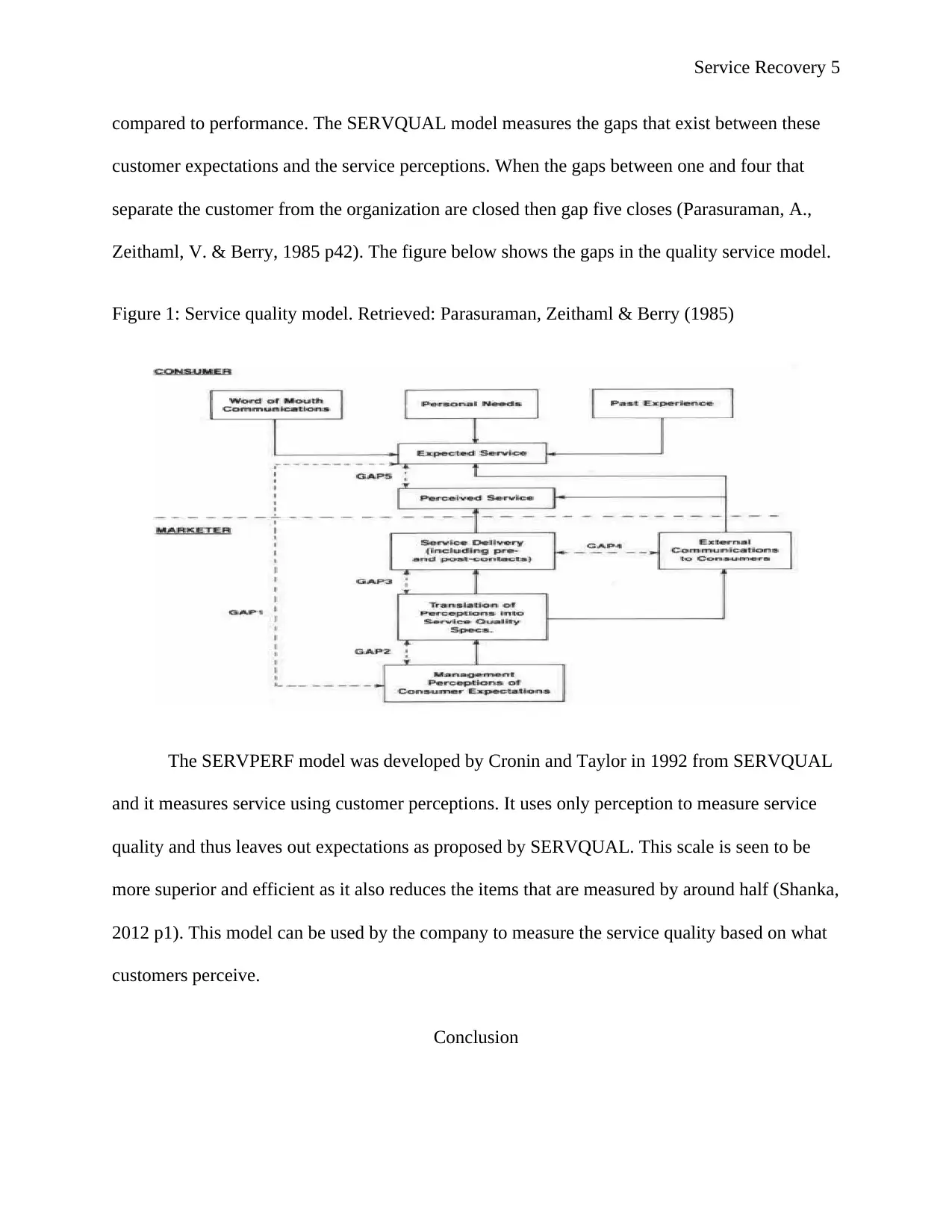
Service Recovery 5
compared to performance. The SERVQUAL model measures the gaps that exist between these
customer expectations and the service perceptions. When the gaps between one and four that
separate the customer from the organization are closed then gap five closes (Parasuraman, A.,
Zeithaml, V. & Berry, 1985 p42). The figure below shows the gaps in the quality service model.
Figure 1: Service quality model. Retrieved: Parasuraman, Zeithaml & Berry (1985)
The SERVPERF model was developed by Cronin and Taylor in 1992 from SERVQUAL
and it measures service using customer perceptions. It uses only perception to measure service
quality and thus leaves out expectations as proposed by SERVQUAL. This scale is seen to be
more superior and efficient as it also reduces the items that are measured by around half (Shanka,
2012 p1). This model can be used by the company to measure the service quality based on what
customers perceive.
Conclusion
compared to performance. The SERVQUAL model measures the gaps that exist between these
customer expectations and the service perceptions. When the gaps between one and four that
separate the customer from the organization are closed then gap five closes (Parasuraman, A.,
Zeithaml, V. & Berry, 1985 p42). The figure below shows the gaps in the quality service model.
Figure 1: Service quality model. Retrieved: Parasuraman, Zeithaml & Berry (1985)
The SERVPERF model was developed by Cronin and Taylor in 1992 from SERVQUAL
and it measures service using customer perceptions. It uses only perception to measure service
quality and thus leaves out expectations as proposed by SERVQUAL. This scale is seen to be
more superior and efficient as it also reduces the items that are measured by around half (Shanka,
2012 p1). This model can be used by the company to measure the service quality based on what
customers perceive.
Conclusion
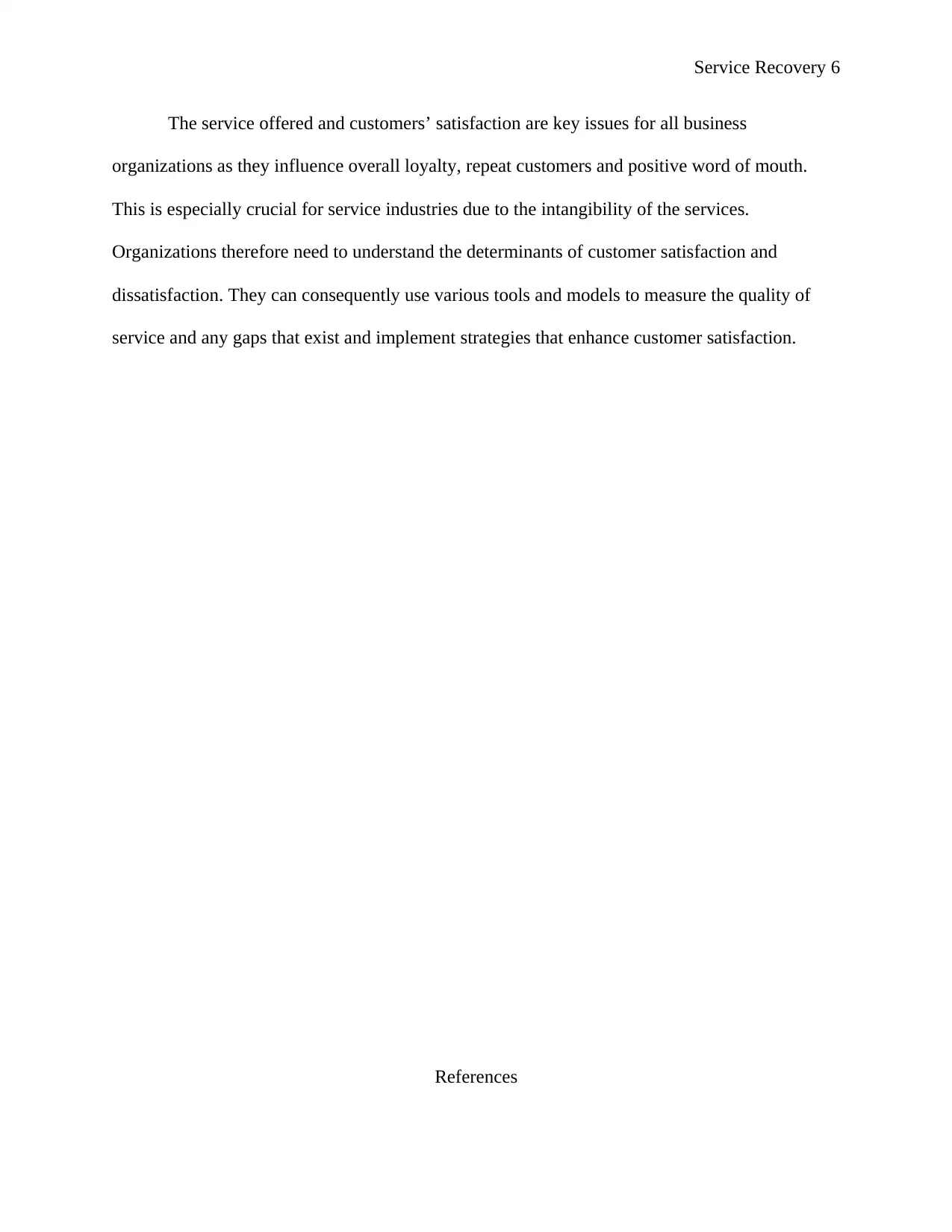
Service Recovery 6
The service offered and customers’ satisfaction are key issues for all business
organizations as they influence overall loyalty, repeat customers and positive word of mouth.
This is especially crucial for service industries due to the intangibility of the services.
Organizations therefore need to understand the determinants of customer satisfaction and
dissatisfaction. They can consequently use various tools and models to measure the quality of
service and any gaps that exist and implement strategies that enhance customer satisfaction.
References
The service offered and customers’ satisfaction are key issues for all business
organizations as they influence overall loyalty, repeat customers and positive word of mouth.
This is especially crucial for service industries due to the intangibility of the services.
Organizations therefore need to understand the determinants of customer satisfaction and
dissatisfaction. They can consequently use various tools and models to measure the quality of
service and any gaps that exist and implement strategies that enhance customer satisfaction.
References
⊘ This is a preview!⊘
Do you want full access?
Subscribe today to unlock all pages.

Trusted by 1+ million students worldwide
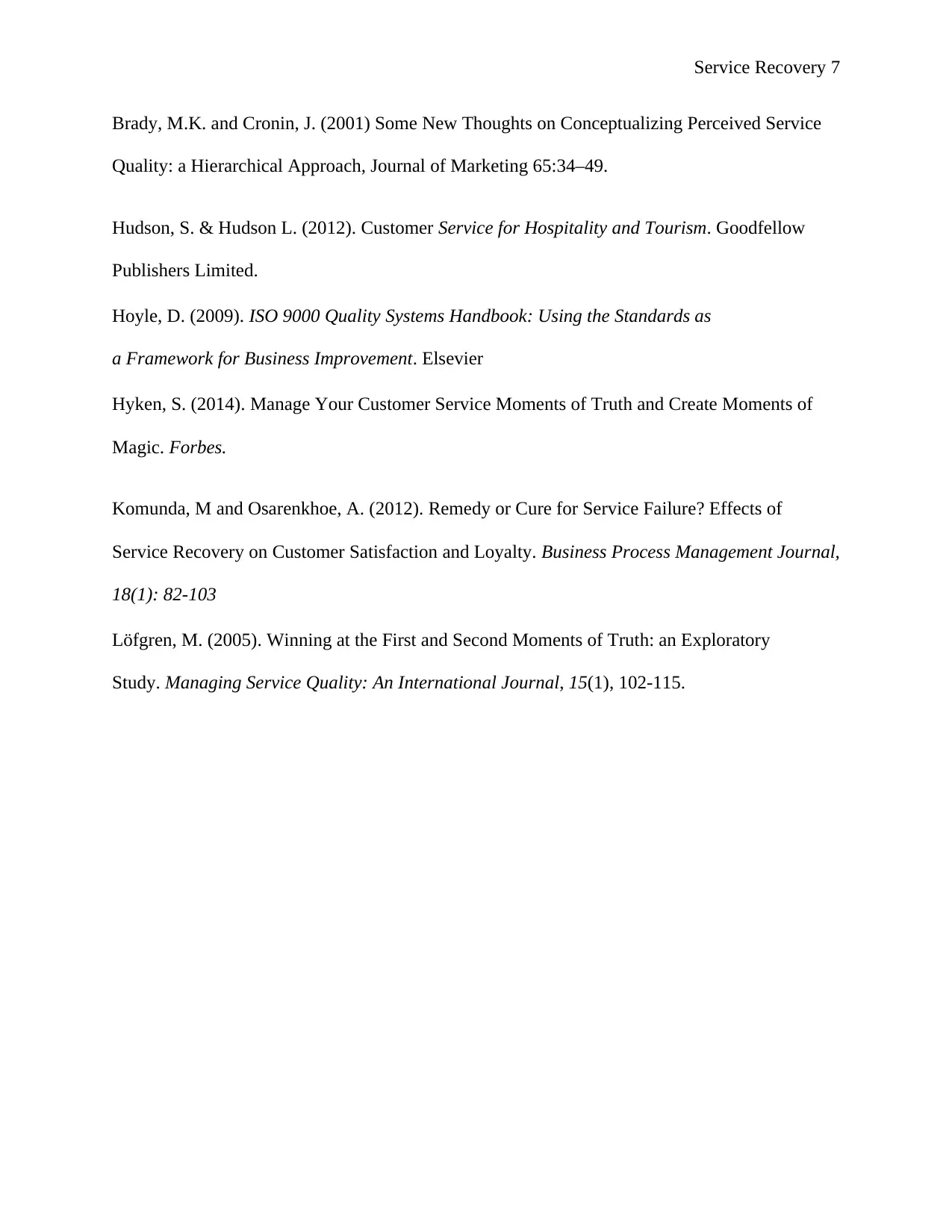
Service Recovery 7
Brady, M.K. and Cronin, J. (2001) Some New Thoughts on Conceptualizing Perceived Service
Quality: a Hierarchical Approach, Journal of Marketing 65:34–49.
Hudson, S. & Hudson L. (2012). Customer Service for Hospitality and Tourism. Goodfellow
Publishers Limited.
Hoyle, D. (2009). ISO 9000 Quality Systems Handbook: Using the Standards as
a Framework for Business Improvement. Elsevier
Hyken, S. (2014). Manage Your Customer Service Moments of Truth and Create Moments of
Magic. Forbes.
Komunda, M and Osarenkhoe, A. (2012). Remedy or Cure for Service Failure? Effects of
Service Recovery on Customer Satisfaction and Loyalty. Business Process Management Journal,
18(1): 82-103
Löfgren, M. (2005). Winning at the First and Second Moments of Truth: an Exploratory
Study. Managing Service Quality: An International Journal, 15(1), 102-115.
Brady, M.K. and Cronin, J. (2001) Some New Thoughts on Conceptualizing Perceived Service
Quality: a Hierarchical Approach, Journal of Marketing 65:34–49.
Hudson, S. & Hudson L. (2012). Customer Service for Hospitality and Tourism. Goodfellow
Publishers Limited.
Hoyle, D. (2009). ISO 9000 Quality Systems Handbook: Using the Standards as
a Framework for Business Improvement. Elsevier
Hyken, S. (2014). Manage Your Customer Service Moments of Truth and Create Moments of
Magic. Forbes.
Komunda, M and Osarenkhoe, A. (2012). Remedy or Cure for Service Failure? Effects of
Service Recovery on Customer Satisfaction and Loyalty. Business Process Management Journal,
18(1): 82-103
Löfgren, M. (2005). Winning at the First and Second Moments of Truth: an Exploratory
Study. Managing Service Quality: An International Journal, 15(1), 102-115.
Paraphrase This Document
Need a fresh take? Get an instant paraphrase of this document with our AI Paraphraser
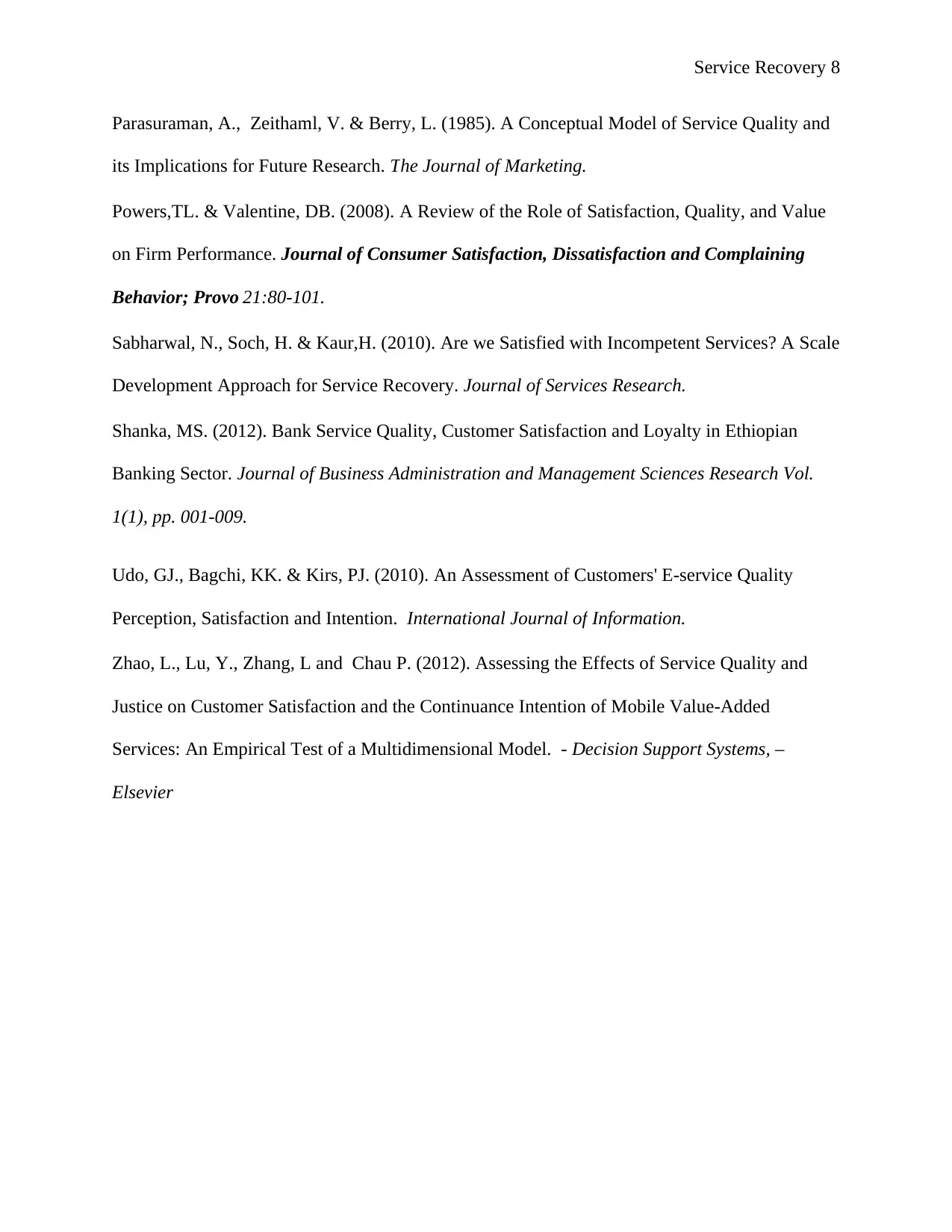
Service Recovery 8
Parasuraman, A., Zeithaml, V. & Berry, L. (1985). A Conceptual Model of Service Quality and
its Implications for Future Research. The Journal of Marketing.
Powers,TL. & Valentine, DB. (2008). A Review of the Role of Satisfaction, Quality, and Value
on Firm Performance. Journal of Consumer Satisfaction, Dissatisfaction and Complaining
Behavior; Provo 21:80-101.
Sabharwal, N., Soch, H. & Kaur,H. (2010). Are we Satisfied with Incompetent Services? A Scale
Development Approach for Service Recovery. Journal of Services Research.
Shanka, MS. (2012). Bank Service Quality, Customer Satisfaction and Loyalty in Ethiopian
Banking Sector. Journal of Business Administration and Management Sciences Research Vol.
1(1), pp. 001-009.
Udo, GJ., Bagchi, KK. & Kirs, PJ. (2010). An Assessment of Customers' E-service Quality
Perception, Satisfaction and Intention. International Journal of Information.
Zhao, L., Lu, Y., Zhang, L and Chau P. (2012). Assessing the Effects of Service Quality and
Justice on Customer Satisfaction and the Continuance Intention of Mobile Value-Added
Services: An Empirical Test of a Multidimensional Model. - Decision Support Systems, –
Elsevier
Parasuraman, A., Zeithaml, V. & Berry, L. (1985). A Conceptual Model of Service Quality and
its Implications for Future Research. The Journal of Marketing.
Powers,TL. & Valentine, DB. (2008). A Review of the Role of Satisfaction, Quality, and Value
on Firm Performance. Journal of Consumer Satisfaction, Dissatisfaction and Complaining
Behavior; Provo 21:80-101.
Sabharwal, N., Soch, H. & Kaur,H. (2010). Are we Satisfied with Incompetent Services? A Scale
Development Approach for Service Recovery. Journal of Services Research.
Shanka, MS. (2012). Bank Service Quality, Customer Satisfaction and Loyalty in Ethiopian
Banking Sector. Journal of Business Administration and Management Sciences Research Vol.
1(1), pp. 001-009.
Udo, GJ., Bagchi, KK. & Kirs, PJ. (2010). An Assessment of Customers' E-service Quality
Perception, Satisfaction and Intention. International Journal of Information.
Zhao, L., Lu, Y., Zhang, L and Chau P. (2012). Assessing the Effects of Service Quality and
Justice on Customer Satisfaction and the Continuance Intention of Mobile Value-Added
Services: An Empirical Test of a Multidimensional Model. - Decision Support Systems, –
Elsevier
1 out of 8
Your All-in-One AI-Powered Toolkit for Academic Success.
+13062052269
info@desklib.com
Available 24*7 on WhatsApp / Email
![[object Object]](/_next/static/media/star-bottom.7253800d.svg)
Unlock your academic potential
Copyright © 2020–2025 A2Z Services. All Rights Reserved. Developed and managed by ZUCOL.

